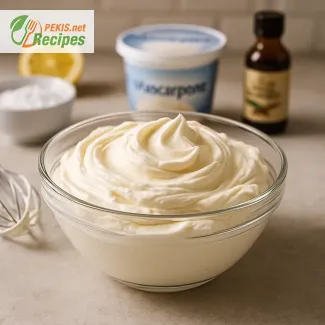
Irresistibly Smooth Mascarpone Dessert Filling
A velvety cream to elevate any cake to a masterpiece
There’s something undeniably magical about the texture and flavor of mascarpone cream—a smooth, rich, and luxuriously light filling that transforms any cake from good to unforgettable. Whether you’re layering it between delicate sponge layers, topping it over moist chocolate cake, or simply serving it with a dusting of cocoa and fresh berries, mascarpone cream for cake is a go-to choice for both home bakers and professional pastry chefs.
At the heart of this delectable cream is mascarpone cheese, a silky Italian specialty known for its mild, buttery flavor and thick consistency. Often associated with desserts like Tiramisu, mascarpone is just as at home in other cakes and confections where a mellow creaminess is desired. Blended with whipped cream, a touch of sweetness, and sometimes a hint of vanilla or citrus zest, this filling strikes the perfect balance between lightness and indulgence.
What sets mascarpone cream apart from other cake fillings is its incredible versatility. It can be used as a frosting, a layered filling, or even piped into choux pastries or cupcake centers. Its stability and smooth texture make it easy to spread and shape, while its neutral flavor profile allows it to complement a variety of cake bases—from classic vanilla sponge to rich devil’s food chocolate.
In celebration cakes, mascarpone cream brings a level of sophistication and subtle sweetness that appeals to all ages. Unlike overly sugary buttercreams, its richness comes from natural dairy fats, giving it a creamy mouthfeel without overwhelming the palate. It pairs beautifully with fresh fruits like strawberries, raspberries, or figs, making it ideal for seasonal and wedding cakes.
Another advantage of mascarpone cream is how quick and easy it is to prepare. With only a handful of ingredients—typically mascarpone, heavy cream, sugar, and perhaps vanilla extract—it can be whipped together in minutes, yet looks and tastes like something that required far more effort. This makes it the perfect choice for both last-minute desserts and elaborate showstoppers.
Whether you’re crafting a rustic naked cake or an elegant layered torte, mascarpone cream filling is a timeless choice that adds a gourmet touch without the fuss. Its delicate flavor acts as a canvas for countless flavor pairings, from coffee and chocolate to lemon zest and berries. With the right consistency, it holds its shape beautifully while remaining light enough to melt on the tongue.
For those who love experimenting, the basic recipe can be easily adapted—add a spoonful of liqueur for an adult twist, fold in cocoa powder for a chocolate version, or blend with fruit puree for a summery variation. The possibilities are endless, but the base remains the same: an ultra-creamy, dreamy filling that never fails to impress.
In short, mascarpone cream is more than just a filling—it’s a transformative element that brings depth, texture, and elegance to your cakes. Its ability to blend seamlessly with other flavors and its lush, whipped texture make it a staple in any baker’s repertoire. From birthday cakes to weekend desserts, this cream ensures that every bite feels like a celebration.
Perfect for special occasions or simple afternoon indulgences, mascarpone cream for cake is the ingredient your baking has been missing. Light, creamy, easy to make, and endlessly versatile—this is one recipe you’ll return to time and again.
- Chill the tools: Place your mixing bowl and beaters in the fridge for 10 minutes before beginning. Cold equipment ensures better whipping of the cream.
- Whip the cream: In the chilled bowl, pour in the heavy whipping cream. Beat with a hand mixer or stand mixer on medium speed until soft peaks form. Be careful not to overwhip.
- Prepare mascarpone mixture: In another bowl, combine the mascarpone cheese, powdered sugar, vanilla extract, lemon zest (if using), and a pinch of salt. Mix gently with a spatula or low-speed mixer just until smooth. Do not overmix, as mascarpone can curdle if handled too much.
- Combine mixtures: Add the whipped cream to the mascarpone mixture in batches. Fold gently with a spatula after each addition to keep the texture light and airy. Avoid overmixing.
- Use immediately or chill: The cream is now ready to be used as a cake filling, frosting, or dessert topping. It can also be refrigerated for up to 24 hours if needed, but use it within the same day for best texture.
Creative Enhancements for a Flawless Mascarpone Filling
Expert tips to refine texture, flavor, and nutrition without compromising indulgence
Mascarpone cream is a time-honored favorite in cake fillings and desserts, cherished for its velvety texture, subtle sweetness, and versatility. But even the most classic recipes can be elevated with small adjustments—whether by improving the flavor profile, modifying the nutritional content, or tailoring it to dietary preferences. In this guide, we explore how to enrich the traditional mascarpone cream for cake with creative flair, practical techniques, and thoughtful ingredient substitutions, all while preserving the luxurious nature of the original.
How ingredient variations influence taste and texture
Mascarpone on its own offers a creamy, slightly tangy profile. However, the addition or substitution of ingredients can dramatically enhance or refine the final result. For instance, incorporating a touch of sour cream (around 30 g / 1 oz) adds a gentle acidity that cuts through the richness and introduces a more complex taste. A dash of almond extract alongside vanilla can add a subtle nutty aroma, especially if pairing with almond sponge or fruit-based cakes.
Swapping part of the powdered sugar for honey or maple syrup introduces depth and natural sweetness, though it's important to account for the added moisture, which may affect the cream's firmness. In such cases, slightly increasing the mascarpone quantity can help restore the desired consistency.
Adding citrus zest, like lemon or orange, brightens the flavor and balances the creaminess. This is particularly effective when the filling is intended for summer cakes or paired with fresh fruit. On the other hand, for more decadent applications like chocolate cakes, folding in melted white chocolate (cooled to room temperature) adds richness and structure, allowing the cream to double as a frosting.
Why homemade makes all the difference
A store-bought mascarpone cream often contains stabilizers, preservatives, or artificial flavors that impact both the taste and texture. In contrast, homemade cream is fresher, silkier, and more customizable. It allows full control over sweetness, density, and flavor intensity. Additionally, homemade preparation ensures the use of high-quality ingredients and the absence of unnecessary additives.
Beyond flavor, making your own mascarpone cream enhances the overall quality of your dessert. When crafted with attention and balance, the cream becomes more than just a filler—it’s a star component that supports and elevates the cake itself.
Common mistakes to avoid when making mascarpone cream
Many home bakers, even experienced ones, encounter pitfalls when preparing mascarpone cream. One of the most frequent mistakes is overbeating the mascarpone, which can cause it to curdle or become grainy. Always beat at low speed and stop as soon as the mixture is smooth.
Another issue arises when ingredients are not at the proper temperature. Mascarpone should be cold, but not too firm, while the whipping cream should be thoroughly chilled. Combining ingredients at uneven temperatures can result in separation or uneven texture.
Overmixing the final cream once the whipped cream is folded in can also deflate its lightness. Use a gentle folding motion and avoid stirring vigorously. Lastly, avoid adding liquid flavorings (like citrus juice or alcohol) in large quantities unless the recipe is adjusted for texture, as they can thin the cream.
Healthier adaptations without sacrificing indulgence
Although mascarpone cream is naturally rich, there are ways to make it lighter and more suitable for various diets. For a reduced-fat version, substitute part of the mascarpone with low-fat ricotta or Greek yogurt. This not only lowers the fat content but also adds a slight tang and additional protein.
For those reducing sugar intake, stevia powder or erythritol can be used instead of powdered sugar. Keep in mind that sugar replacements may affect the final texture slightly, so test small batches before applying to a full cake.
Plant-based alternatives are also gaining popularity. Vegan mascarpone substitutes made from blended cashews or soy provide a creamy base. When paired with coconut cream or oat whipping cream, the result is remarkably similar in consistency and mouthfeel, making the dessert accessible for people with dairy allergies or following a vegan lifestyle.
Best flavor pairings to experiment with
Once the cream is perfected, its potential for pairing is virtually endless. If you're looking to infuse the cream with character, try lavender or rose water for floral undertones. These delicate enhancements are perfect for wedding cakes or elegant tarts.
For a cozy winter variation, consider adding a pinch of ground cinnamon or nutmeg, or even folding in a spoonful of mascarpone blended with pumpkin puree for a spiced seasonal delight.
Fruit purees like raspberry, mango, or passionfruit also bring a vibrant contrast to the rich cream. These can be layered within the cake or gently folded into the cream itself, creating a two-tone swirl effect.
Turn a classic into a signature
Enhancing a traditional mascarpone cream recipe doesn’t require a complete overhaul—just thoughtful modifications that align with your cake’s flavor profile, audience, and occasion. Whether you're aiming for a more health-conscious version, a flavor-rich variation, or simply wish to avoid common pitfalls, these tips help you transform a beloved recipe into a custom creation.
Mascarpone cream is more than a filler—it's an opportunity to infuse your cakes with personality, richness, and flair. A small touch, a mindful substitution, or a splash of inspiration can turn this classic into your personal signature.
Allergens and gluten:
- Contains: Milk (from mascarpone and cream)
- Gluten-free by nature
- To make it dairy-free, substitute mascarpone with a vegan mascarpone alternative (based on cashews or soy) and replace cream with full-fat coconut cream or oat whipping cream.
- Vitamin A: 950 IU – supports eye health and immune function
- Vitamin D: 18 IU – important for bone strength and calcium absorption
- Calcium: 105 mg – supports bone and tooth structure
- Phosphorus: 95 mg – helps energy metabolism and cell function
- Potassium: 120 mg – maintains normal fluid balance and nerve function
- Vitamin E: 0.6 mg – helps protect cells from oxidative stress
- Selenium: 2.2 µg – supports antioxidant enzyme function
- Zinc: 0.5 mg – contributes to immune system maintenance
This simple yet indulgent cream adds elegance to any cake and is easily adaptable to dietary needs without compromising its smooth, luxurious texture.





